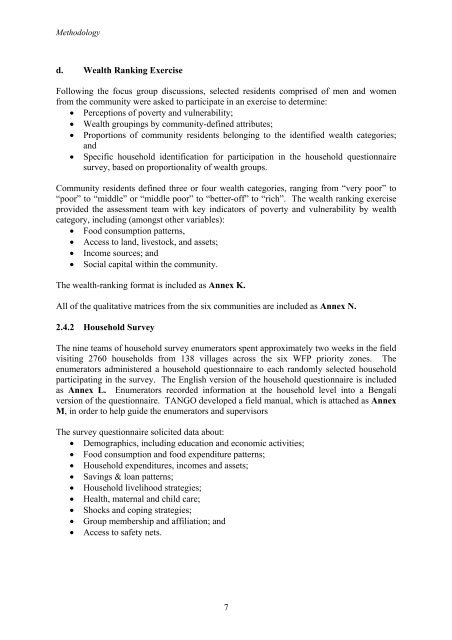RURAL BANGLADESH - PreventionWeb
RURAL BANGLADESH - PreventionWeb
RURAL BANGLADESH - PreventionWeb
You also want an ePaper? Increase the reach of your titles
YUMPU automatically turns print PDFs into web optimized ePapers that Google loves.
Methodology<br />
d. Wealth Ranking Exercise<br />
Following the focus group discussions, selected residents comprised of men and women<br />
from the community were asked to participate in an exercise to determine:<br />
• Perceptions of poverty and vulnerability;<br />
• Wealth groupings by community-defined attributes;<br />
• Proportions of community residents belonging to the identified wealth categories;<br />
and<br />
• Specific household identification for participation in the household questionnaire<br />
survey, based on proportionality of wealth groups.<br />
Community residents defined three or four wealth categories, ranging from “very poor” to<br />
“poor” to “middle” or “middle poor” to “better-off” to “rich”. The wealth ranking exercise<br />
provided the assessment team with key indicators of poverty and vulnerability by wealth<br />
category, including (amongst other variables):<br />
• Food consumption patterns,<br />
• Access to land, livestock, and assets;<br />
• Income sources; and<br />
• Social capital within the community.<br />
The wealth-ranking format is included as Annex K.<br />
All of the qualitative matrices from the six communities are included as Annex N.<br />
2.4.2 Household Survey<br />
The nine teams of household survey enumerators spent approximately two weeks in the field<br />
visiting 2760 households from 138 villages across the six WFP priority zones. The<br />
enumerators administered a household questionnaire to each randomly selected household<br />
participating in the survey. The English version of the household questionnaire is included<br />
as Annex L. Enumerators recorded information at the household level into a Bengali<br />
version of the questionnaire. TANGO developed a field manual, which is attached as Annex<br />
M, in order to help guide the enumerators and supervisors<br />
The survey questionnaire solicited data about:<br />
• Demographics, including education and economic activities;<br />
• Food consumption and food expenditure patterns;<br />
• Household expenditures, incomes and assets;<br />
• Savings & loan patterns;<br />
• Household livelihood strategies;<br />
• Health, maternal and child care;<br />
• Shocks and coping strategies;<br />
• Group membership and affiliation; and<br />
• Access to safety nets.<br />
7












![View full document [PDF 988.55 KB] - PreventionWeb](https://img.yumpu.com/47733942/1/184x260/view-full-document-pdf-98855-kb-preventionweb.jpg?quality=85)
![View full document (in French) [PDF 4.96 MB] - PreventionWeb](https://img.yumpu.com/47223870/1/184x260/view-full-document-in-french-pdf-496-mb-preventionweb.jpg?quality=85)


![View full document [PDF 25.02 MB] - PreventionWeb](https://img.yumpu.com/44204570/1/190x234/view-full-document-pdf-2502-mb-preventionweb.jpg?quality=85)
